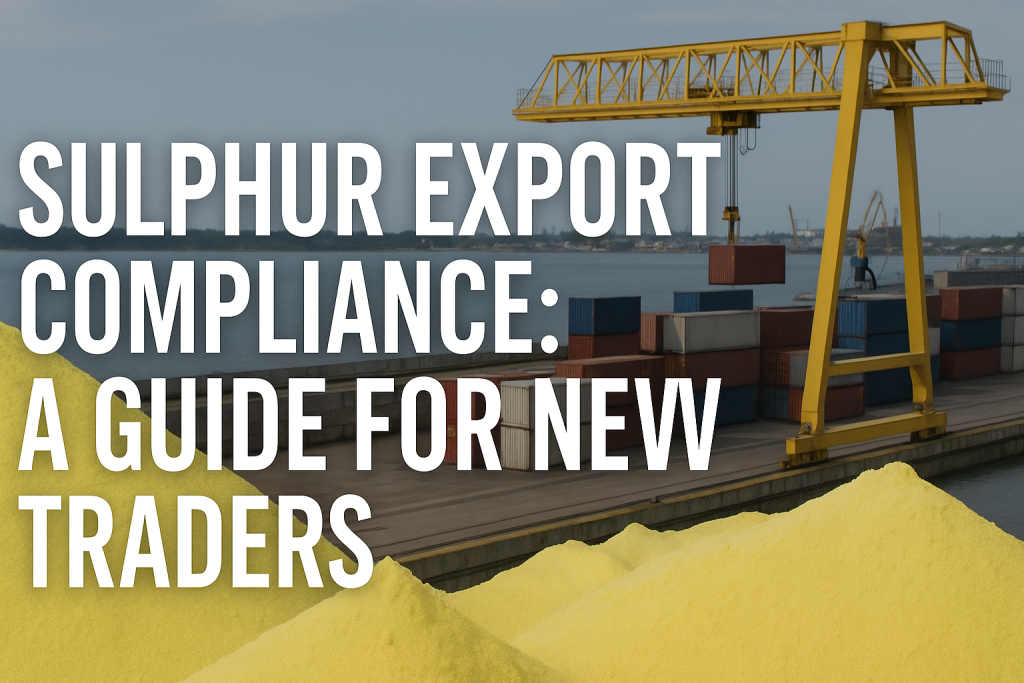
Understanding Sulphur and Its Global Trade Relevance
Sulphur is a critical industrial element used in manufacturing fertilizers, chemicals, pharmaceuticals, and petroleum refining. With global demand soaring, particularly from countries like India, China, and Brazil, sulphur trading has become a lucrative opportunity. However, entering the sulphur export market comes with stringent compliance requirements. As responsible exporters, we must ensure adherence to international, national, and environmental laws to avoid penalties and build a reliable global presence.
Licensing and Registration Requirements
Before exporting sulphur, new traders must register with relevant authorities in their country. This typically involves:
- Obtaining an Exporter’s Registration Certificate from the Ministry of Trade or Commerce.
- Registering with customs authorities for an Exporter Identification Number (EIN).
- Filing for a chemical export license if sulphur is classified as a controlled substance in your jurisdiction.
Countries like the UAE, Saudi Arabia, and Turkmenistan—major sulphur exporters—enforce strict export control systems. Failure to secure proper documentation can lead to shipment seizures.
Harmonized System (HS) Code Classification
Accurate HS code classification is essential for customs declarations, tax tariffs, and regulatory compliance. Sulphur typically falls under:
- HS Code 2503 for elemental sulphur in bulk.
- HS Code 2802 for chemically refined sulphur or sulphur dioxide.
Misclassification can result in delayed clearance, fines, or even criminal charges. Engage with a licensed customs broker to ensure the correct classification aligned with the sulphur product’s nature and end-use.
Complying with Environmental and Safety Regulations
Sulphur, though non-toxic in solid form, becomes hazardous in molten or powdered states. International bodies like the International Maritime Organization (IMO) and International Air Transport Association (IATA) have detailed protocols for sulphur transport:
- Use UN-approved packaging and labeling.
- Attach Material Safety Data Sheets (MSDS).
- Comply with IMO Class 4.1 (Flammable Solids) if applicable.
- Adhere to REACH compliance in the European Union.
Non-compliance can result in serious accidents, port bans, and insurer rejection of liability.
Documentation Checklist for Sulphur Exporters
To avoid disruptions, every shipment must be accompanied by the following documents:
- Commercial Invoice
- Packing List
- Bill of Lading or Air Waybill
- Certificate of Origin
- MSDS (Material Safety Data Sheet)
- Export Permit
- Insurance Certificate
Proper documentation ensures traceability, safety, and fast customs clearance.
Understanding Destination Country Requirements
Every importing country has its own compliance rules. For instance:
- India requires sulphur importers to register with the Directorate General of Foreign Trade (DGFT) and clear imports via Fertilizer Quality Control.
- China mandates pre-shipment inspection (PSI) and stringent environmental impact assessments.
- European Union traders must meet REACH registration and compliance if importing more than one ton annually.
Always coordinate with local representatives or freight forwarders to ensure up-to-date regulations are followed.
Trade Sanctions and Export Restrictions
Sulphur is sometimes used in sensitive applications such as explosives manufacturing. Therefore, it may be subject to trade sanctions or embargoes in conflict zones or politically sensitive regions. Exporters must:
- Check UN, EU, and OFAC sanction lists regularly.
- Secure dual-use export control licenses, if applicable.
Violations can lead to multinational bans, criminal charges, and business dissolution.
Packaging and Labeling Requirements
Proper packaging is not only a safety measure but also a legal requirement. Guidelines include:
- Using corrosion-resistant, sealed containers for elemental sulphur.
- Labeling packages with hazard class symbols and handling instructions.
- Providing temperature control warnings for molten sulphur.
- Ensuring GHS-compliant labeling with appropriate pictograms and signal words.
Consistent packaging ensures regulatory compliance and builds buyer confidence.
Shipping and Logistics Best Practices
Exporters must choose the most efficient and compliant mode of transport:
- Bulk shipments via ocean freight are most common.
- Use IMO-certified carriers for hazardous materials.
- Partner with logistics providers experienced in chemical transportation.
- Track shipments using real-time freight platforms for transparency.
Maintain backup documentation and route planning to tackle unforeseen delays.
Insurance and Risk Management
Sulphur exports involve operational, legal, and environmental risks. Therefore:
- Secure marine cargo insurance covering loss, damage, and liability.
- Opt for product liability insurance if selling to end-users.
- Consider political risk coverage for exports to unstable regions.
- Engage in frequent risk assessments and maintain a compliance checklist.
An insured supply chain demonstrates professionalism and commitment to reliability.
Customs Clearance and Duties
Different countries have unique customs duty structures and clearance times. Some useful tips:
- Declare correct transaction value and freight cost.
- Use trade agreements (e.g., GCC, SAFTA) to lower duties.
- Pre-clear shipments electronically where possible.
- Maintain digital records of prior exports for audits.
Clearances can be accelerated with Authorized Economic Operator (AEO) status or similar certification.
Working with Verified Buyers and Agents
Due diligence on trading partners reduces compliance risks. Best practices include:
- Verifying buyers via business registries and trade references.
- Drafting clear Incoterms and payment terms.
- Using irrevocable Letters of Credit (LC) for new buyers.
- Avoiding overreliance on freelance intermediaries or unverified agents.
A transparent network helps you navigate global markets confidently.
Record-Keeping and Audit Readiness
Maintaining records is not optional—it’s a legal obligation in most jurisdictions. Ensure:
- A digital archive of all shipment documents and permits.
- Backups for three to seven years, depending on country laws.
- Regular internal compliance audits.
This practice supports regulatory reviews, tax compliance, and legal defenses.
Emerging Trends in Sulphur Export Regulations
The future of sulphur export is moving toward digital compliance platforms and AI-driven logistics tracking. New traders should stay updated on:
- Blockchain-based trade facilitation systems.
- Green shipping mandates under IMO 2030 targets.
- Cross-border e-invoicing regulations in the EU and GCC.
- Automated export control systems.
Early adoption of such innovations positions traders as industry leaders.
Conclusion
Entering the sulphur export market offers immense opportunities, but only to those who navigate its compliance maze responsibly. By following best practices, meeting all legal obligations, and staying alert to policy changes, new traders can build a sustainable, profitable, and compliant sulphur export business.
